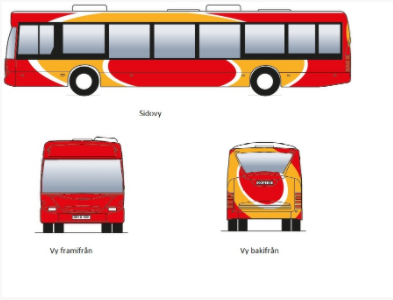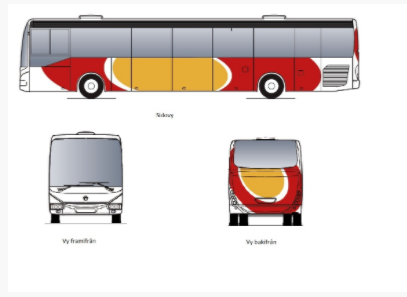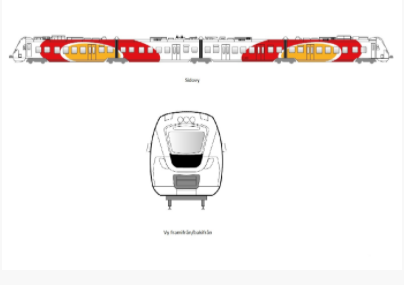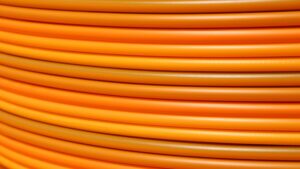02/12/2020
The CJEU have recently issued a judgment in Case C-456/19, referred from the Swedish Patent and Market Court of Appeal. The case centred on whether a trade mark consisting of colour combinations, intended to be systematically affixed to goods used to deliver the services covered by an application, must depart significantly from the norms and customs of the commercial sector in order for the trade mark to have distinctive character. This is a test which has been applied in relation to 3D trade marks but we have not seen it applied to these type of colour combination marks before.
Background
The Appellant in the main proceedings, transport company Östgötatrafiken, filed three Swedish trade mark applications on 23 November 2016 in class 39 for transport services for the marks shown below:

[Swedish trade mark number 2016/08169]

[Swedish trade mark number 2016/08170]

[Swedish trade mark number 2016/08171]
These applications were accompanied with the description “Colouring of vehicles in the colours red, white and orange, as shown” along with a statement that those applications “did not concern the actual shape of the vehicles or the fields of the colour black or grey covering that shape.”
All three applications were rejected by the Swedish Patent and Registration Office (PRV) on the basis that the marks are merely decorative and that they could not be perceived as signs capable of distinguishing the services covered by the applications. Therefore the marks were devoid of distinctive character.
Appeal to Patents and Market Court, Sweden
On appeal, the Appellant (Östgötatrafiken) argued that the marks applied for were ‘position marks’, which were to be placed in specific positions on buses and trains which would be used to provide the transport services covered by the applications. To this end, and to make it clear that the applications were not seeking protection for the shape of the vehicles, the Appellant also provided further images of the marks with the vehicle outlines shown in dotted lines.
The Appellant is also the proprietor of the following three figurative trade marks, applied for and registered as Swedish national trade marks in 2003:

The Appellant argued that the impression created by these figurative marks is comparable to the impression created by the marks applied for and that the distinctive character should not be assessed differently just because the marks applied for are intended to be placed in specific positions. The Appellant also added that transport companies commonly affix graphics of colour schemes to their vehicles and so consumers will view such graphics or colours as indicators of the commercial origin of the transport services.
The PRV argued that, contrary to the Appellant’s arguments, the marks applied for were not comparable to its earlier figurative registrations because they did not concern figurative marks in the abstract, but figurative elements that appear on the Appellant’s vehicles.
The PRV also argued that commercial transport vehicles are “often decorated with coloured motifs” and that consumers would regard such motifs as decoration unless they had taken steps to familiarise themselves with such motifs beforehand. Consequently, PRV argued that “the signs at issue in the main proceedings could be perceived as an indication of commercial origin only if they differed sufficiently from the norm or customs in the sector, which is not the case.”
The appeal was dismissed as the Court sided with the PRV and held that the evidence provided did not show that the marks applied for departed from the norms or customs of decoration of commercial transport vehicles and so the marks will not be perceived by the relevant public as an indication of commercial origin.
Appeal to Patents and Market Court of Appeal
On further appeal, the Swedish Patents and Market Court of Appeal stayed the proceedings and referred two questions to the CJEU:
- Must Article 4(1)(b) of [Directive 2015/2436] be interpreted as meaning that, in the case of an application for registration of a trade mark which designates services and where the application relates to a sign, placed in a particular position, which covers large areas of the physical objects used to perform the services, it must be assessed whether the mark is not independent of the appearance of the objects concerned?
- If the first question is answered in the affirmative, is it necessary for the trade mark to depart significantly from the norm or customs of the economic sector concerned in order for the mark to be regarded as having distinctive character?
The questions essentially asked the CJEU to determine whether the distinctive character of systematically arranged colour combinations, which are to be applied to goods used to deliver a service, must be assessed by examining whether the sign departs significantly from the norm or customs of the economic sector concerned.
CJEU Decision
The CJEU began by stating that Directive 2008/95 was in force at the filing date of the applications, not Directive 2015/2436 that the Swedish courts had referred to.
The CJEU then pointed out that, “although the colour motifs to which the applications for registration at issue in the main proceedings relate are intended to be affixed in a specific manner to a large part of the goods used for the provision of transport services, the appellant in the main proceedings has expressly stated that the shape of those goods was not, as such, the object of those applications.”
The PRV and Swedish courts had therefore been wrong to base the assessment of distinctive character on whether the marks applied for depart significantly from the norm or customs of the economic sector concerned. The CJEU highlighted that this criterion of assessment applies in relation to applications for shape marks and applications for marks which represent the layout of a physical space where the applied for services are provided. The CJEU confirmed that the criterion does not apply in the present case “where the signs at issue consist of graphic elements intended to be affixed to goods which are used to provide the services designated by the application for registration.”
The CJEU emphasised that in relation to the marks applied for, which concerned signs “consisting of coloured motifs which are intended to be applied exclusively and systematically to goods used for the provision of services”, the distinctive character must be assessed “by taking into account the perception of the relevant public of the affixing of that sign to those goods, without it being necessary to examine whether that sign departs significantly from the norm or customs of the economic sector concerned”.
The CJEU concluded that it is for the referring court to determine whether the systematically arranged colour combinations applied for are capable of conferring inherent distinctive character on the marks, by assessing the perception of the relevant public. The CJEU also iterated that even if the colour combinations are not inherently distinctive, they may still be distinctive after use. This may leave the door open for Östgötatrafiken to provide evidence of such acquired distinctiveness, in the event that its applications are found to lack inherent distinctiveness.
Comment
The CJEU’s judgement reminds us of the key role that the perception of the relevant public has in assessing the distinctiveness of a sign. It also highlights that distinctiveness criterion applicable to certain categories of trade mark, such as shape marks, should be reserved to such categories and not expansively applied to other categories of non-traditional trade marks.
This case has now been sent back to Patents and Market Court of Appeal for a decision. Even though CJEU has made clear that the PRV and Swedish Patents and Market Court had applied the incorrect criterion to the assessment of distinctive character, it is still open to Swedish court to decide that the marks applied for are devoid of distinctive character by reference to the perception of the relevant public. We note that systematic colour combinations have often faced issues with distinctiveness and so we wait with interest for the decision of the Patents and Market Court of Appeal.
This article is for general information only. Its content is not a statement of the law on any subject and does not constitute advice. Please contact Reddie & Grose LLP for advice before taking any action in reliance on it.


